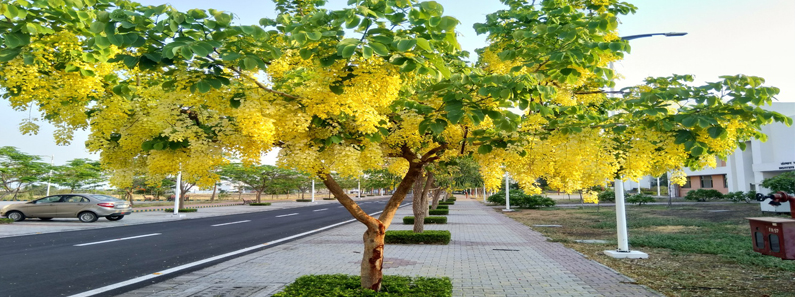Best Books to Read in 2023
Best Books to Read in 2023 Are you a bookworm or a bibliophile, if yes, then this is the ...
IISER Bhopal researchers have completed the first-ever genome sequencing of the Jamun tree (Syzygium cumini), an evergreen tree popular in India for its medicinal properties, fruits, and ornamental value.
 To understand the genomic and evolutionary basis of the tree’s medicinal values, IISER Bhopal researchers sequenced the S.cumini genome from the world’s largest tree genus Syzygium using Oxford Nanopore and 10x Genomics sequencing technologies.
To understand the genomic and evolutionary basis of the tree’s medicinal values, IISER Bhopal researchers sequenced the S.cumini genome from the world’s largest tree genus Syzygium using Oxford Nanopore and 10x Genomics sequencing technologies.
Jamun is the largest genome to be sequenced from the world’s largest tree genus, Syzygium, say IISER Bhopal researchers.
The team of IISER Bhopal researchers, led by Dr. Vineet K. Sharma, Professor, Department of Biological Sciences, includes Abhisek Chakraborty, Shruti Mahajan, and Manohar Singh Bisht from IISER Bhopal.
Their findings have been published in the peer-reviewed journal Frontiers in Plant Science. (https://doi.org/10.3389/fpls.2023.1260414)
Dr. Vineet K Sharma, Department of Biological Sciences, IISER Bhopal explained the aim behind the research done by IISER Bhopal researchers.
He the aim of this research was to gain new functional and evolutionary insights from the Jamun genome, which could be responsible for the wide range of pharmacological properties of this species conferred by the bioactive compounds that act as nutraceutical agents in modern medicine.
Dr. Vineet K Sharma highlighted the insights gained from this research by IISER Bhopal researchers. He said taken together, it is tempting to speculate that the adaptive evolution of major plant secondary metabolism pathways in S. cumini species confers unprecedented antidiabetic, antioxidant, anti-inflammatory, and other pharmacological properties of this tree.
Also read – Clash of Exams: AILET vs. AIBE – A Tough Choice for Law Graduates
Further, the whole genome sequence of S. cumini will facilitate future genomic, evolutionary, and ecological studies on the world’s largest tree genus, he said speaking about the research by IISER Bhopal researchers team.
 Syzygium cumini
Syzygium cuminiSyzygium cumini, often known as Jamun, jambolan, or black plum, is a Myrtaceae plant family tropical tree. Its natural range includes the Indian Subcontinent and South-East Asia.
The clove genus, Syzygium, is the world’s biggest tree genus, with 1,193 recognised species, of which Jamun is one, say IISER Bhopal researchers.
Jamun’s therapeutic properties are widely celebrated in India. Specifically, the fruit seed extracts of Jamun have well-known anti-diabetic properties, say IISER Bhopal researchers.
It is also highly recommended in Ayurveda to treat a variety of health ailments such as stomach discomfort, arthritis, cardiac problems, flatulence, asthma, diarrhea, and stomach spasms, say IISER Bhopal researchers.
The black plum can be eaten fresh or made into juice.
Not just Ayurveda but multiple clinical studies in the past have also shown the health benefits of Jamun due to it being an excellent source of bioactive components such as flavonoids, polyphenols, antioxidants, iron, and vitamin C. This attempt by IISER Bhopal is the first time that the plant has been examined and decoded so closely.
The Jamun genome has a higher number of coding genes resulting from gene duplication events compared to the other two sequenced species from this genus, which points towards a neopolyploidy event in the Jamun species.
This duplication of genes can allow Jamun to acquire novel functions, say IISER Bhopal researchers.
Their analyses revealed the key genes involved in facilitating the adaptive evolution of Jamun.
Among these, 14 genes allow for the biosynthesis of terpenoids, which are a diverse class of metabolites that are responsible for plant defense responses, say IISER Bhopal researchers.
These also contribute significantly to the anti-oxidant and anti-inflammatory properties offered by the tree’s leaves and seeds, say IISER Bhopal researchers.
Moreover, alkaloids, another type of metabolite, are also abundantly found in different plant parts and offer curative properties against many diseases.
This combination of alkaloids along with flavonoids is what gives the plant its anti-arthritic properties, the researchers suggest.
Jamun has been considered one of the best home remedies for treating arthritis since ancient times, say IISER Bhopal researchers.
 Anti-diabetic Properties
Anti-diabetic PropertiesTo fully explain the anti-diabetic properties of this plant, the researchers discovered the presence of glucosides, another class of metabolites that prevent the conversion of starch into sugar, and explain how the plant possesses anti-diabetic value, say IISER Bhopal researchers.
Previous clinical assessments have shown that Jamun has a low glycemic index and alleviates diabetic symptoms such as excessive urination, say IISER Bhopal researchers.
Jamun also has various genes that make the plant rugged and improve its stress tolerance to factors like weeds and insects that induce damage, heat stress, salinity, and drought.
This points to remarkable adaptive evolution in Jamun, the research team finds.
S Vishnu Sharmaa now works with collegechalo.com in the news team. His work involves writing articles related to the education... (Full bio)

Best Books to Read in 2023 Are you a bookworm or a bibliophile, if yes, then this is the ...

In the exhilarating journey of 10 Proven Memorize Techniques for Students learning, memory is your trusty companion. Whether ...

Top 20 toughest exams in world is about exams in the world that required very hard work to ...

Top 20 toughest exams in India - Exams are the perhaps most toughest moments for any student. A ...

Top 20 Colleges of DU Getting admissions to the top 20 colleges of DU is a dream for every ...

Top 20 NITs of India - Amongst the 31 NITs in India, today, we are talking ...

Here are the Top 12 Artificial Intelligence in Mumbai. Artificial intelligence (AI) refers to the simulation of human ...

As you stand on the Best Science Courses after 12th academic journey, the realm of science beckons, offering ...
Millions of students have entrusted CollegeChalo to facilitate their seamless and smooth admission process to their dream colleges and universities. With CollegeChalo, you can gain a competitive edge by easily accessing exam and course details to stay ahead of the admission journey. What are you waiting for?
Search your dream college